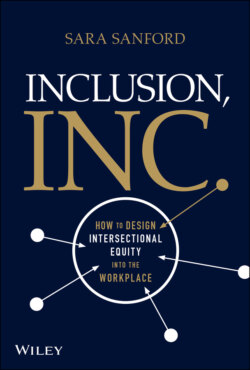Читать книгу Inclusion, Inc. - Sara Sanford - Страница 36
The Best Person for the Job
Оглавление“I don't hire for diversity. I just hire the best person for the job.”
I hear this “best person for the job” objection to diversity initiatives most often in fields that tend to think of themselves as meritocracies. The tech industry isn't alone in its perception of itself as meritocratic, but it does give us a good example of how this belief plays out.
In a (since deleted) article in Forbes, tech industry commentator Brian S. Hall declared, “If you aren't able to make it here [Silicon Valley], it's almost certainly not because of any bias.” Anyone claiming bias, he argued, should blame their own “refusal to put in the hard work.”20
It appears that bias may play a bigger role than Hall realized. A 2012 randomized, double-blind study found that when hiring managers in STEM fields were given application materials of a fictitious candidate randomly assigned a male or female name, both male and female hiring managers rated the male applicant as significantly more competent and hirable than the woman with identical application materials.21 A similar 2014 study found that both men and women working in tech fields were twice as likely to hire a man for a job that required math, even when presented with female applicants who were equally qualified.22
The “pipeline problem” is a common excuse used to explain away the underrepresentation of tech workers of color. The numbers tell a different story. According to a USA Today study, Black and Hispanic computer science and computer engineering students graduate from top universities at three times the rate that top tech companies hire them.23 Even when Black and Hispanic graduates each made up 9 percent of computer science degrees earned, the sector continued to hire only 2 percent Black and 3 percent Hispanic tech workers.
If they do manage to get hired, underestimated employees face promotion processes that are framed as meritocratic, but actually lead to biased outcomes. Many tech companies have jettisoned long-standing traditions of managers choosing who gets promoted. Instead, they've embraced a more crowd-sourced approach: Those who self-nominate and receive the most peer accolades are chosen to advance.
As we learned in the previous chapter, when women and minorities advocate for themselves, they can disrupt unconscious expectations of how they should behave, triggering negative reactions from their peers. The self-nominating phase of the tech promotions process puts these employees in a double bind. They can self-nominate and risk retaliation, or say nothing and risk being passed over for promotions.
The second stage of the promotion process—peer approval—triggers in-group favoritism, an implicit bias in which people are more likely to support others who remind them of themselves. In the largely white and male world of tech, this phenomenon scales to a widespread advantage for other white men.
The inherently biased dynamics of self-nomination and peer approval put underestimated groups at a disadvantage. Returning decision-making power to the masses may have been seen as promoting fairness and performance-based competition, but it has actually tilted the playing field in favor of bias, not merit.
Tech isn't the only industry suffering from this mismatch of meritocratic beliefs and favoritism-fueled outcomes. Across the US we treasure the idea that we are a meritocracy, and this belief that we reward people for their efforts and abilities actually keeps us from hiring the “best person for the job.”
